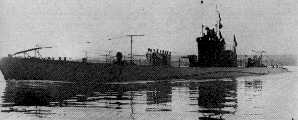During the period between 1925 and 1940, the Regia Marina dedicated large resources to the strengthening of its submarine force, which resulted in the deployment of 50 large, 89 medium, 2 cargo and 50 small units. At the beginning of the hostilities (June 10th, 1940), Italy had a total of 117 units of which only 7 could be categorized as obsolete.

R.Smg. Mameli
The first medium displacement boats built were the four 830 ton “Mameli” in 1929. Later units had larger displacements. In 1932, Italy began producing the class “600”, units of only 650 tons. The same configuration was maintained on the “Sirena” (12 units), the “Perla” (10 units), the “Adua” (17 units). The “Platino” class (13 units) were increased to 710 tons.
From experience gather during the initial days of the war, displacement of all units was increased, with the Tritone class (13 units) reaching 905 tons. The first large submarines were the 4 units of the Balilla class. These double-hull, 1405-ton units were first deployed in 1928. Later models were decreased to about 1,100 tons, with the only exception of the ocean-going “Ammiragli” class (4 units), and the 2 transports of the “R” class.
R.Smg. Argonauta (Class 600)
Most medium and large units were armed with a single gun, placed in front of the cunning tower. Some had a second gun place on the turret itself or just behind it. Torpedo launchers were installed both forward and aft. Usually, medium size units had two tubes aft and four forward. Some had a four and four configuration with the only exception of the “Bragadin” class, which had the aft torpedo tubes replaced by mine laying devices.
R.Smg. Foca
Large units were usually configured with four and four tubes, with the exception of the Balilla, which had only two stern tubes. The Foca, which was dedicated to mine laying, was equipped with only two tubes installed under the aft mine-laying devices. The ocean-going “Ammiragli” class was equipped with six forward and four aft tubes. These were 450 mm torpedoes (nicknamed silurotti, small torpedoes) instead of the standard 533 mm ones. The “R” class, which was exclusively used for transport, did not have torpedoes.
The standard propulsion system consisted of diesel engines for surface navigation and electric motors for submerged one. The “Ammiragli” and Balilla class had a third diesel engine attached to a dynamo used to produce electricity for surface navigation, thus providing for low-speed long-range capabilities.
R.Smg. Cagni (Class Ammiragli)
Although in 1922 the Regia Marina had began research on submerged navigation using diesel engines, a device invented by Major Pericle Ferretti was never fully deployed. Even while collaborating with the German Navy, Italy never implemented this Dutch-invented device, known as the schnorchel, thus greatly impeding the performances of all of its submarines.
At the fall of France, Italy was able to set up an Atlantic submarine base in Bordeaux, thus eliminating the perilous passage through the Gibraltar Strait. Admiral Donitz, the supreme German submarine commander, attempted to integrate the Italian forces in the Wolf-pack strategy, but the Italian boats were technically poor, slow to dive and possessed a large and easily detectable profile. As a result, most Italian submarines operated in the Central and Southern Atlantic in solitary missions.
Adapted and translated from the book “Guida alle navi d’Italia”, by Gino Galuppini, published in 1982 by Arnoldo Mondadori Editore.